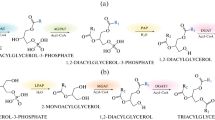Abstract
A particulate enzyme fraction fromMycobacterium smegmatis catalyzed the transfer of14C-glucose from UDP-14C-glucose into neutral glycolipids. The two major radioactive components were purified by column chromatography on 0-diethylamino ethyl cellulose (acetate) and thin layer chromatography on silica gel in several solvents. The first product yielded a water-soluble component upon saponification, which had a hexoseglycerol ratio of 1∶1 with all of the hexose being identified as glucose. The second product yielded a water-soluble component upon saponification which contained hexose and glycerol in a 2∶1 ratio and, in addition to glucose, contained lesser amounts of mannose and galactose. Palmitate and oleate were the predominant fatty acids and were present in equimolar amounts. The products thus have been identified as monoglycosyldiglyceride and diglycosyldiglyceride. The diglycosyldiglyceride could also be labeled with14C-galactose when UDP-14C-galactose served as the donor, but the monoglycosyldiglyceride was only slightly labeled with14C-galactose. Membrane fractions from mung bean seedlings catalyzed the transfer of14C-glucose from UDP-14C-glucose into a neutral glycolipid which has been purified by thin layer chromatography and analyzed by combined gas liquid chromatographymass spectrometry. It was determined to be a steryl glucoside with the two major sterol components being β-sitosterol and stigmasterol linked to β-D-glucose. Particulate fractions from developing cotton fibers also catalyzed the formation of steryl glucosides and, in addition, they catalyzed the esterification of steryl glucosides at the 6 position of glucose with fatty acids (primarily palmitate and oleate) from an endogenous acyl donor. Both the glucosyl transferase and the acyltransferase have been solubilized with Triton X-100 and partially purified by chromatography on Sephadex G-200. The acyltransferase activity was reconstituted by the addition of the steryl glucoside and a phospholipid acyl donor.
Similar content being viewed by others
References
Schultz, J.C., and A.D. Elbein, J. Bacteriol. 117:107 (1974).
Forsee, W.T., R.A. Laine, and A.D. Elbein, Arch. Biochem. Biophys. 161:248 (1974).
Laine, R.A., and A.D. Elbein, Biochemistry 10:2547 (1971).
Hakomori, S., J. Biochem. 55:205 (1964).
Sanford, P.A., and H.E. Conrad, Biochemistry 5:1508 (1966).
Bjorndal, H., C.G. Hellerquist, B. Lindberg, and S. Svensson, Angew. Chem., Int. Ed. Engl. 9:610 (1970).
Carter, G.E., and J.L. Koob, J. Lipid Res. 10:363 (1969).
Author information
Authors and Affiliations
About this article
Cite this article
Elbein, A.D., Forsee, W.T., Schultz, J.C. et al. Biosynthesis and structure of glycosyl diglycerides, steryl glucosides, and acylated steryl glucosides. Lipids 10, 427–436 (1975). https://doi.org/10.1007/BF02532449
Received:
Issue Date:
DOI: https://doi.org/10.1007/BF02532449




